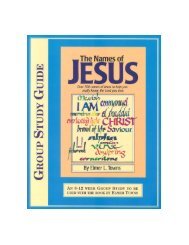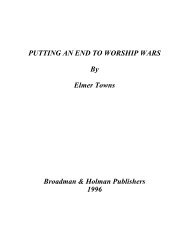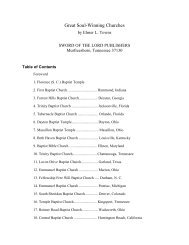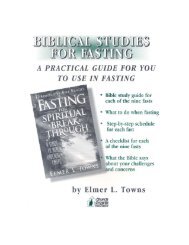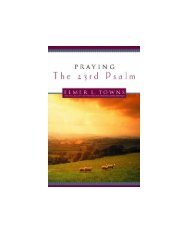The Names of Jesus - Elmer Towns
The Names of Jesus - Elmer Towns
The Names of Jesus - Elmer Towns
- TAGS
- elmer
- towns
- elmertowns.com
Create successful ePaper yourself
Turn your PDF publications into a flip-book with our unique Google optimized e-Paper software.
members <strong>of</strong> His body, retain an independent will by which they can and too <strong>of</strong>ten do refuse the<br />
directives <strong>of</strong> the head.<br />
That Christ is called “the head <strong>of</strong> the body” implies several truths concerning His<br />
relationship to the church. First, it means His purposes cannot be frustrated; He holds ultimate<br />
control. Even if one part <strong>of</strong> the body is rebellious and does not respond to His directives, another<br />
will respond. Secondly, it suggests that no individual member within that body can be the<br />
organic head <strong>of</strong> it. Attempts to do so will be frustrated, as in the case <strong>of</strong> Diotrephes, “who loveth<br />
to have the preeminence among them” (III John 9). <strong>The</strong> place <strong>of</strong> preeminence in the church<br />
belongs to <strong>Jesus</strong> alone. “And he is the head <strong>of</strong> the body, the church: who is the beginning, the<br />
firstborn from the dead; that in all things he might have the preeminence” (Colossians 1:18).<br />
<strong>The</strong> practical implication <strong>of</strong> this title <strong>of</strong> Christ relates to our submission to <strong>Jesus</strong> as the<br />
head <strong>of</strong> the body. He demands our obedience to His will and reverential worship <strong>of</strong> His Person.<br />
Anything less falls short <strong>of</strong> a personal acknowledgment <strong>of</strong> <strong>Jesus</strong> as the Head <strong>of</strong> the Body.<br />
THE SHEPHERD OF THE SHEEP<br />
Scripture <strong>of</strong>ten refers to the church as the flock <strong>of</strong> God, and so it is not surprising that the<br />
Lord should bear the title “Shepherd.” When He sees the multitudes <strong>of</strong> people, He sees them<br />
“scattered abroad, as sheep having no shepherd” (Matthew 9:36). He was the Good Shepherd in<br />
His death (John 10:11; Psalm 22), the Great Shepherd in His resurrection (Hebrews 13:20; Psalm<br />
23) and will be the Chief Shepherd in His return to this earth (I Peter 5:4; Psalm 24). Unlike the<br />
hireling whose primary concern is himself, <strong>Jesus</strong> cares for His sheep. He has entrusted the care<br />
<strong>of</strong> parts <strong>of</strong> His flock to others called “pastors,” or more literally, “shepherds.” <strong>Jesus</strong> the shepherd<br />
is the model for pastors in caring for the flock. <strong>The</strong> title “shepherd” was also one <strong>of</strong> the<br />
Jehovistic names <strong>of</strong> <strong>Jesus</strong> in the Gospel <strong>of</strong> John.<br />
THE BRIDEGROOM OF THE BRIDE<br />
When John the Baptist became the first to call <strong>Jesus</strong> “the bridegroom” (John 3:29), the<br />
term was already rich in meaning. <strong>The</strong> Old Testament frequently portrayed Israel as the wife <strong>of</strong><br />
the Lord (Isaiah 54:6; Jeremiah 31:32; Hosea 2:1-23). As John on that occasion noted, “He that<br />
hath the bride is the bridegroom” (John 3:29). This title was to have special significance in the<br />
New Testament, not for Israel as the wife <strong>of</strong> God but, rather, for the church, which is the bride <strong>of</strong><br />
Christ. <strong>The</strong> relation between the bride and Bridegroom is most fully taught in a passage in which<br />
the Apostle Paul addresses several principles <strong>of</strong> family living (Ephesians 5:25-27). <strong>The</strong>se verses<br />
emphasize that Christ loved the church, gave Himself for it, purposes to sanctify and cleanse it<br />
by the Word <strong>of</strong> God, and promises to take it to Himself as a perfected bride. This work <strong>of</strong> Christ<br />
began in eternity past when He determined to die for her because <strong>of</strong> his love for her and will be<br />
consummated in the new Jerusalem when we shall with John see “the holy city, new Jerusalem,<br />
coming down from God out <strong>of</strong> heaven, prepared as a bride adorned for her husband” (Revelation<br />
21:2).<br />
<strong>The</strong> image <strong>of</strong> the bride and Bridegroom serves to emphasize the need for qualitative or<br />
spiritual church growth-that is, growth in our love for Christ. <strong>The</strong> church was “espoused” to




